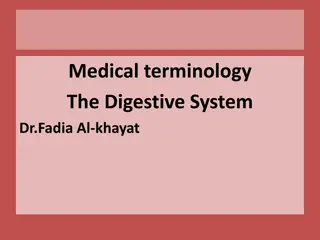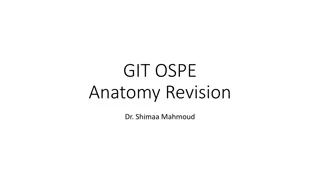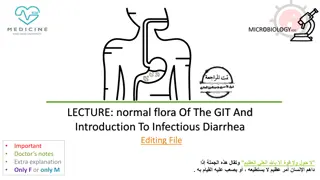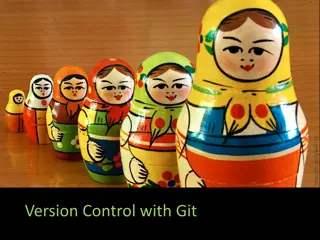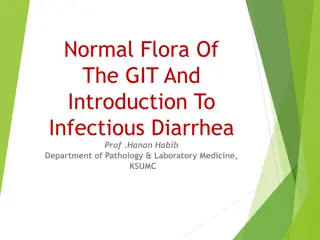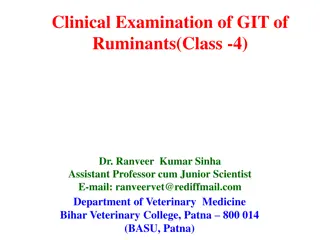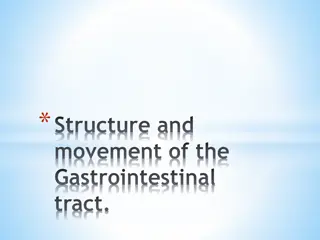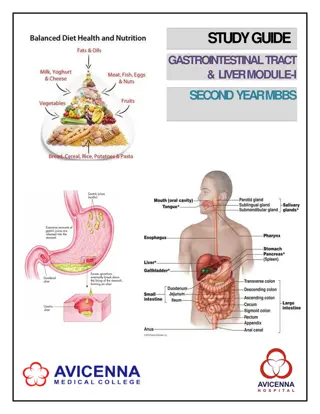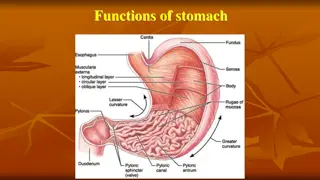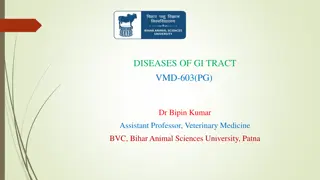Understanding the Secretions of the Gastrointestinal Tract (GIT)
The gastrointestinal tract (GIT) is responsible for digestion, absorption, and secretion through various glands along the alimentary canal. Secretions are stimulated by factors like direct contact, nervous system activation, and hormonal regulation. Hormones released in response to food presence help regulate glandular secretion in the stomach and intestines. Salivary glands in the mouth secrete saliva containing enzymes, mucus, and ions crucial for lubrication and digestion. Understanding GIT secretions is essential for comprehending the digestive process.
Download Presentation

Please find below an Image/Link to download the presentation.
The content on the website is provided AS IS for your information and personal use only. It may not be sold, licensed, or shared on other websites without obtaining consent from the author. Download presentation by click this link. If you encounter any issues during the download, it is possible that the publisher has removed the file from their server.
E N D
Presentation Transcript
SECRETIONS OF THE GIT SECRETIONS OF THE GIT GROUP 3 OYAKHILOME OMOTESE 17/MHS05/018 ABOHWO KESSIENA 17/MHS01/006 UWADIALE DESMOND 17/MHS01/316
The Gastro intestinal tract (GIT) also known as the alimentary canal which runs from the mouth through the esophagus to the stomach and then into the intestines where its terminates at the anus. It involves or undergoes multiple activities including digestion, absorption and secretion. The secretion occurs through multiple glands located through out the alimentary canal which secretes certain fluids as a result of stimulation from i. Direct contact- The presence of food in a particular segment of the gastrointestinal tract usually stimulates the glands of that region and adjacent regions to secrete moderate to large quantities of juices. Part of this local effect, especially the secretion of mucus by mucous cells, results from direct contact stimulation of the surface glandular cells by the food. Also, tactile stimulation, chemical irritation, and distention of the gut wall are resulting nervous reflexes that stimulate both the mucous cells on the gut epithelial surface and the deep glands in the gut wall to increase their secretion. ii. Nervous system (Sympathetic and Parasympathetic stimulation)- Stimulation of the sympathetic nerves going to the gastrointestinal tract causes a slight to moderate increase in secretion by some of the local glands and also results in constriction of the blood vessels that supply the glands. If there s already a parasympathetic or hormonal stimulation the sympathetic stimulation causes a decrease in secretion. Stimulation of the parasympathetic nerves to the alimentary tract almost invariably increases the rates of alimentary glandular secretion. This increased secretion rate is especially true of the glands in the upper portion of the tract (innervated by the glossopharyngeal and vagus nerve) such as the salivary glands, esophageal glands, gastric glands, pancreas, and Brunner s glands in the duodenum Regulation of Glandular Secretion by Hormones- In the stomach and intestine, several different gastrointestinal hormones help regulate the volume and character of the secretions. These hormones are liberated from the gastrointestinal mucosa in response to the presence of food in the lumen of the gut. The hormones are then absorbed into the blood and carried to the glands, where they stimulate secretion. This type of stimulation is particularly valuable to increase the output of gastric juice and pancreatic juice when food enters the stomach or duodenum. Everyday, about 7L of these fluids are secreted in the GIT and they contain enzymes, ions, mucus,water etc. which aid or help in GIT lubrication and digestion and occur mostly in the mouth (salivary glands),
MOUTH (SALIVA) MOUTH (SALIVA) The mouth which is the initial part of the GIT contains multiple glands including the principal gland -Parotid gland -Submandibular gland -Sublingual gland Along with other smaller buccal glands which are responsible for the secretion of about 0.8-1.5L of saliva in the mouth each day which contains 99% water and 1% solids. The saliva secreted contains mucus that contains mucin for lubricating and for surface protective purposes and serous proteins secretions that contains ptyalin (an -amylase), which is an enzyme for digesting starches, along with enzymes like amylase, lysozyme, lingual lipase which aid in the digestion in the mouth e.g. protein digestion. Saliva contains potassium and bicarbonate ions, sodium and chloride ions. The parotid glands secrete almost entirely the serous type of secretion, whereas the submandibular and sublingual glands secrete both serous secretion and mucus. The buccal glands secrete only mucus. Saliva has a pH between 6.0 and 7.0, which supports the digestive action of ptyalin. The secretion of salivary fluids and proteins is controlled by autonomic nerves. The salivary glands are supplied by cholinergic parasympathetic nerves which causes the saliva secretion from the acinar cells in the salivary gland and are also supplied by some sympathetic nerves that cause greater release of stored proteins from ductal and acinar cells
ESOPHAGUS ESOPHAGUS The esophagus contains multiple glands including the: - The simple/ proper mucus glands which lines the main body of the esophagus located in the upper third of the esophagus. It secretes mucin/mucus for the lubrication of the esophagus - The compound mucous glands- *located near the cardiac orifice of the stomach at the esophago-gastric junction. It secretes mucous to protect the esophageal wall from the acidic gastric juices that may result in peptic ulcer *located at the upper esophagus at the pharyngo-esophangeal junction. It secretes mucous to prevent wearing off of the esophageal by newly ingested food. All the enzymes located in the esophagus originate from the saliva produced in the mouth
STOMACH STOMACH The stomach plays major roles in digestion both in a mechanical sense by mixing and crushing the food and also in the enzymatic sense by digesting it. The secretion in the stomach is done by the cells and glands in the stomach Cells including the Parietal cells, g cell, gastric chief cells, mucous neck and pit cells which secrete mucus and bicarbonate. The three glands located in the stomach are found beneath the gastric pits within the gastric mucosa (the mucous membrane of the stomach) surrounded or housed by innumerable gastric pits. The glands include: i. Cardiac glands found in the cardia of the stomach which is the part nearest to the heart where the esophagus joins the stomach. They secrete mucus primarily and are fewer in number than other glands and are shallowly positioned in the mucosa and can either b of the simple tubular or the compound racemose type. ii. Fundic (oxyntic) glands found in the fundus or the body of the stomach. They are straight multiple tubes which open into single duct and secrete hydrochloric acid and intrinsic factors iii. Pyloric glands are located in the antrum of the pylorus of the stomach that secretes gastrin produced by g cells The stomach also secretes multiple gastric enzymes and hormones including- Pepsin- is a main gastric enzyme produced by chief cells I its inactivated form pepsinogen which is activated by stomach acid. It aids in the breaking down of protein into smaller particles e.g. amino acid Gastric lipase is an acidic lipase secreted by the chief cells in the fundic mucous Gastrin is a important hormone produced by the g cells in the stomach. It is produced in response to stomach stretching occurring after food enters it and also after stomach exposure to protein
PANCREAS PANCREAS It functions to produce endocrine hormones released into circulatory system (such as insulin and glucagon) to control glucose metabolism and also secrete digestive exocrine pancreatic juice. Pancreatic juice composed of both the ductal and acinar cells contains enzymes such as i. Trypsinogen which is an inactive protease that is activated in the duodenum via the duodenal enzyme enterokinase into its active form trypsin and breaks down proteins at the basic amino acids. ii. Chymotrypsinogen which is an active protease that once activated by duodenal enterokinase turns into chymotrypsin and breaks down proteins at their aromatic amino acids and can by activated by trypsin iii. Carboxypeptidase which is a protease that takes off the terminal amino acid group from a protein iv. Pancreatic Lipase that degrades triglycerides into two fatty acids and a monoglycerides. Along with these enzymes they also secrete hormones including- Secretin- is produced in response to stomach chyme and is released into the blood stream upon its release into the GIT. It decreases gastric emptying and increases secretion of pancreatic cells (ductal and acinar) for the production of zymogene juice. Cholecystokinin is a unique peptide that is released by the duodenal cells that increases gall bladder contraction. Gastric inhibitory peptide is produced by the mucosal duodenal cells in response to chime containing high amounts of carbohydrate, proteins and fatty acids. Its main function is gastric emptying. Somatostatin is a hormone produced by the mucosal cells of the duodenum and also the decta cell of the pancreas
INTESTINES INTESTINES The intestinal glands - The crypts of lieberkuhn or intestinal glands are simple tubular glands of intestine. They do no penetrate the muscularis mucosae of the intestinal wall but open into he lumen of the intestine. The also consist of interposed cells including i. Argentaffin cells or enterochromaffin cells which secrete intrinsic factors ii. Goblet cells which secrete mucus iii. Paneth cells which secrete cytokines In addition to the intestinal glands, the Brunner s gland, the mucus glands located in the duodenum. These glands penetrate the musclaris mucosa and extend to the sub mucous coat of the intestinal wall, it opens into the intestinal lumen directly and secretes mucus and traces of enzymes. The enzymes/ hormones secreted by the intestines include Secretin- produced by duodenal S cells in response to acidity of gastric chime Cholecystokinin- is a unique peptide released by the duodenal I cells in response to chyme containing fat and protein Gastric Inhibitory peptide- it decreases gastric motility and is produced by duodenal mucosal cells Motilin It increases gastro- intestinal motility Somatostatin It inhibits various secretory mechanism Along the lining of the intestines are enzymes that break stomach chyme further into absorbable particles and the include Erepsin- Converts polypeptides to amino acids Maltase- Converts maltose to glucose Lactase- Converts glucose to galactose Sucrase- Converts sucrose into glucose and fructose




